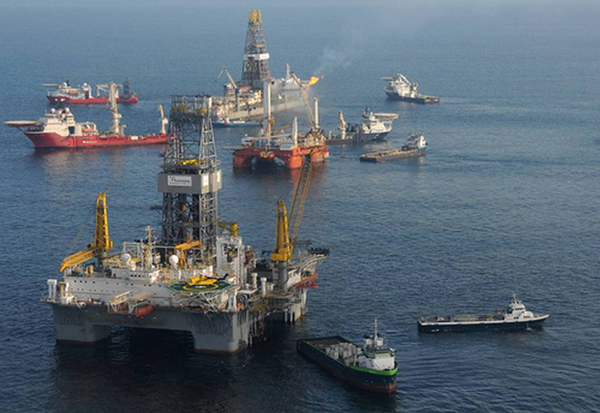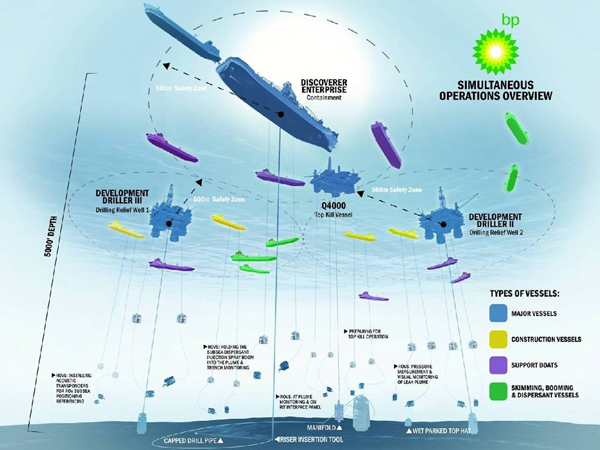When there are shortcuts and things go very very wrong, it is costly business. Check out the SIMOPS currently underway ......
Oil Operations at Transocean Deepwater Horizon Disaster Location
Here is the latest story which sounds pretty feasible!!!
The following is my theory on what happened on April 20th. I have listed factual information to the best of my knowledge, and base this theory on 33 years of experience working on these rigs, with 16 years working as a consultant worldwide. The contractor (Transocean in this case) typically does not do anything without direction and approval from the operator (BP in this case). I believe that there was nothing wrong with the BOP, or the conduct of the crews prior to the catastrophic failure. If any operator drills a similar well using the same flawed casing and cement program, the same results will be very possible.
The well was drilled to 18,360 ft and final mud weight was 14.0 ppg. The last casing long string was 16 inch and there were 3 drilling liners (13 5/8”, 11 7/8” and 9 7/8”) with 3 liner tops. A 9-7/8” X 7” tapered casing long string was run to TD. The bottom section of casing was cemented with only 51 barrels of light weight cement containing nitrogen, a tricky procedure, especially in these conditions.
The casing seal assembly was set in wellhead and pressure tested from above to 10,000 psi. Reportedly, a lock down ring was not run on the casing hanger. The casing string was pressure tested against the Shear rams, only 16.5 hours after primary cement job. A negative test on the wellhead packoff was performed.
The rig crew was likely lead to believe that the well was successfully cemented, capped and secured. Normally a responsible operator will not remove the primary source of well control (14.0 ppg drilling mud) until such conditions were met. However, the crews were given the order to displace heavy mud from riser with seawater, prior to setting the final cement plugs. They were pumping seawater down the drill string and sending returns overboard to workboat, so there was limited ability to directly detect influx via pit level. This is the fastest way to perform the displacement operation, and the method was likely directed and certainly approved by operator. There was a sudden casing failure during this displacement procedure that allowed the well to unload, with ignition of gas and oil. Evidently, the crew was able to get the diverter closed based on initial photographs, showing flames coming out of diverter lines.
It is likely that pressure built up between the 9 7/8” and 16" casing under the casing hanger, due to gas migration from the pay zone. Based on reported mud weight, the reservoir formation pressure is in excess of 13,000 psi. The pressure building in the cross sectional area below the casing hanger would have increased casing tension and caused casing to collapse and part (rapidly separate) at a connection, probably a joint or two (50’ or 90’) below wellhead. The collapse pressure for 62.8 ppf 9-7/8” casing is +/- 10,300 psi. However, the collapse resistance of casing is considerably reduced in presence of axial stress (i.e. tension). Engineers - see formula from API bulletin 5C3, section 2.1.5 and run the math. The well then came in violently through parted casing and caused the blowout. Without lockdown ring on hanger, the casing hanger and joint(s) were slingshot up into BOP. That would explain why all components of the BOP are unable to seal or shear. The parted casing section remains across all BOP ram cavities and probably all the way up into the riser.
Shortcut #1: Running a tapered long string rather than a liner with 9-7/8” liner top packer, followed by tieback string and pumping heavy cement all the way to seabed. Perhaps the original permits for this casing program were based on a planned appraisal well, and changed midstream to a producer well, then hastily approved by the complacent or under-staffed MMS. This tragic shortcut may have saved about 1.5 rig days.
Shortcut #2: Insufficient time was used to cure the mud losses prior to cementing the open hole reservoir section, depending instead on using lightweight cement to prevent losses to the formation.
Shortcut #3: The nitrified primary cement job. This is difficult to pull off, even under ideal conditions.
Shortcut #4: Hanger without lock ring may have used due to the previously unplanned long string, and to avoid waiting for hanger with lock ring to be fabricated or prepared.
Shortcut #5: No cement evaluation logs were performed after a job with known high calculated risk (mud losses to formation). This shortcut may have saved 8 hours of rig time.
Shortcut #6: Pressure testing casing less than 24 hours after cement in place can expand the casing before the cement is fully set. This shortcut can “crack” the cement and create a micro annulus which will allow gas migration.
Shortcut #7: Displacing 14 ppg mud from 8000 ft MDRT with 8.7 ppg seawater, less than 20 hours after primary cement is in place. How many tested and proven barriers can you count? I count zero satisfactory barriers. Industry standards dictate that at least two tested (to maximum anticipated pressure) barriers are in place prior to removing the primary source of well control (weighted mud or brine).











This is consistent with what I learned from other engineers involved in deep water drilling.
ReplyDelete